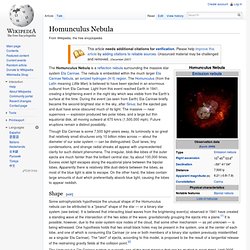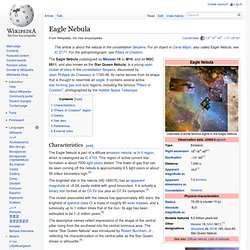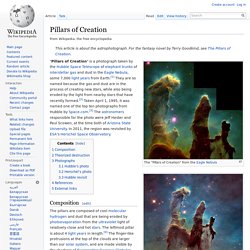

IC 1101. Size[edit] The galaxy's diffuse stellar halo light extends to at least 1.4 million light years, which makes it one of the largest known galaxies in terms of breadth.[2] It is the central galaxy of a massive cluster containing a mass (mostly dark matter) of roughly 100 trillion stars.[3][4] IC 1101 in X-ray (left) and the Abell 2029 galaxy cluster in visible light (right).

Homunculus Nebula. The Homunculus Nebula is a reflection nebula surrounding the massive star system Eta Carinae.

The nebula is embedded within the much larger Eta Carinae Nebula, an ionized hydrogen (H II) region. The Homunculus (from the Latin meaning Little Man) is believed to have been ejected in an enormous outburst from Eta Carinae. Light from this event reached Earth in 1841, creating a brightening event in the night sky which was visible from the Earth's surface at the time. During the event (as seen from Earth) Eta Carinae briefly became the second-brightest star in the sky, after Sirius; but the ejected gas and dust have since obscured much of its light. 1036 Ganymed. 1036 Ganymed is the largest near-Earth asteroid, at about 32–34 km in diameter.

It was discovered by Walter Baade on October 23, 1924. It has a very well determined orbit, and its next pass of the Earth will be at a distance of 0.374097 AU (55,964,100 km; 34,774,500 mi) on 13 October 2024.[7] It is an Amor asteroid, and also a Mars-crosser asteroid, and will pass 0.02868 AU (4,290,000 km; 2,666,000 mi) from Mars on 16 December 2176.[7] Name[edit] Physical characteristics[edit] Owing to its early discovery date, Ganymed has a rich observational history. In 1998, radar observations of Ganymed by the Arecibo radio telescope produced images of the asteroid, revealing a roughly spherical object.[9] Also around this time a study of several asteroids' visual lightcurves (variation of light intensity over time) and polarization curves was conducted (the data for Ganymed is limited due to poor weather at the time).
Sirius. Sirius appears bright because of both its intrinsic luminosity and its proximity to Earth.

At a distance of 2.6 parsecs (8.6 ly), as determined by the Hipparcos astrometry satellite,[5][19][20] the Sirius system is one of Earth's near neighbors. Sirius is gradually moving closer to the Solar System, so it will slightly increase in brightness over the next 60,000 years. After that time its distance will begin to recede, but it will continue to be the brightest star in the Earth's sky for the next 210,000 years.[21] Sirius A is about twice as massive as the Sun (M☉) and has an absolute visual magnitude of 1.42.
It is 25 times more luminous than the Sun[7] but has a significantly lower luminosity than other bright stars such as Canopus or Rigel. Observational history[edit] Sirius, known in ancient Egypt as Sopdet (Greek: Σῶθις Sothis), is recorded in the earliest astronomical records. Oort cloud. An artist's rendering of the Oort cloud and the Kuiper belt (inset).

Sizes of individual objects have been exaggerated for visibility. Eagle Nebula. A view of the stellar spire within M16, the Eagle Nebula.

The Eagle Nebula (catalogued as Messier 16 or M16, and as NGC 6611, and also known as the Star Queen Nebula) is a young open cluster of stars in the constellation Serpens, discovered by Jean-Philippe de Cheseaux in 1745-46. Its name derives from its shape that is thought to resemble an eagle. It contains several active star-forming gas and dust regions, including the famous "Pillars of Creation", photographed by the Hubble Space Telescope. Characteristics[edit] The Eagle Nebula is part of a diffuse emission nebula, or H II region, which is catalogued as IC 4703. The brightest star in the nebula (HD 168076) has an apparent magnitude of +8.24, easily visible with good binoculars. Pillars of Creation. A high-resolution version of Pillars of Creation, taken in 2014 as a tribute to the original photograph "Pillars of Creation" is a photograph taken by the Hubble Space Telescope of elephant trunks of interstellar gas and dust in the Eagle Nebula, some 7,000 light years from Earth.[1] They are so named because the gas and dust are in the process of creating new stars, while also being eroded by the light from nearby stars that have recently formed.[2] Taken April 1, 1995, it was named one of the top ten photographs from Hubble by Space.com.[3] The astronomers responsible for the photo were Jeff Hester and Paul Scowen, at the time both of Arizona State University.

In 2011, the region was revisited by ESA's Herschel Space Observatory. Composition[edit] The pillars are composed of cool molecular hydrogen and dust that are being eroded by photoevaporation from the ultraviolet light of relatively close and hot stars. File:Star-sizes.jpg.